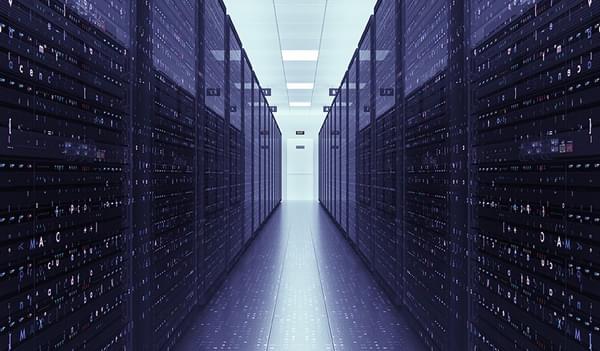Data Centres: 5 big themes to watch out for in 2024
We're in the middle of a tech revolution, made possible by data centres. Here's what a healthy digital infrastructure is going to need.

“ Data centres have a complex, unique set of needs. They require efficiency, sustainability and operational excellence. That means enormous amounts of constant power to function as customers expect, and that means innovative and bespoke design solutions. ”
Chris Jones
Technical director, MEP

Data centres stand as vital hubs of modern technology, enabling us all to live our digital lives without blinking an eye. That does, however, mean they have enormous power demands that must be maintained at all costs, requiring highly secure and protected spaces with an uninterruptible power supply.
With the global data centre market projected to skyrocket to $344 billion by 2030, it’s a high-reward-high-risk industry, with potential losses during outages mounting to thousands of dollars per minute. As such, it’s vital that they are designed to meet those unique demands as efficiently as possible.
Here are 5 key themes we’re expecting to see more of as the sector grows:
1. Meeting data centres’ huge demands for power
Data centres require huge amounts of power that must be maintained at all costs. Globally, datacentre infrastructure is expected to more than double by 2026, going from two to four percent of all electrical demand – adding the equivalent of a new medium-sized European nation. And we know that there is already a huge demand, and long wait times, to power new developments in the UK.
Access to power is the most strategic 'make or break' moment for investors, developers and operators of data centres. It's the first call on whether a site is viable.
However, we’re seeing a shift towards incorporating sustainable design and power options rather than solely wait for the Grid. By having renewable energy sources and battery storage options on-site, it will be possible for data centre operators to be able to own and control their own power source. Microgrid options enable sites to engage with the Grid smartly, using generated energy during peak times and storing energy when demand is at its lowest.
That’s also a positive step towards meeting net zero objectives, reducing the need for diesel dependent back-up generators. Discussions around powering data centres with electricity generated by nuclear power, in the form of Small Modular Reactors are also gaining traction.
2. Designing for structural efficiency
We know that data centres have specific requirements to maximise the efficiency of the equipment stored within. But the way the building itself is designed can maximise its operational efficiency. As large-scale multi-storey buildings with high loads and a high demand for resilience, the structures of data centres have a high demand for materials. Intelligent design can significantly reduce material usage, leading to notable cost savings and a lower carbon footprint.
Two guiding principles for material efficiency are design rigour and standardisation of geometries. Rigorous testing and analysis are crucial to optimise structural arrangements, especially considering the repeatable nature and high loads of data centres. Structural systems can replace individual elements for greater efficiency.
The way the structure and equipment within a data centre interact can also improve system efficiency and resilience. For example, if an engineer understands the way air flows through a space, they can design structural arrangements that improve the pressure distribution and air flow above a data hall, leading to a better performing design.
Structural design can also facilitate off-site manufacturing, which is beneficial for data centres with tight schedules and repetitive construction needs. Overall, intelligent design in data centre structures not only enhances efficiency but also supports timely project delivery.
3. Keep the lights on, put the fires out
Fires in data centres have been reported to set the operators back millions, both in terms of the impact of fire and through rendering the stored data unavailable to customers during downtime.
The main causes of fire are electrical equipment, cabling, HVAC infrastructure, external hazards and fire system malfunctions. But for most data centre and server room operators, potential fires are not actually the main issue. The key concern is to avoid having to cut the power to equipment at all costs. Customers are dependent on digitally stored information so no data centre can afford downtime – it could be a breach of contract.
This means data centres require a bespoke and expert fire safety solution. Methods include rack-level protection (detecting and extinguishing electrical fires at their earliest stage), fire sprinkler systems, portable extinguishing equipment and passive fire protection – how the building is designed to delay the spread of fire through fire compartmentation.
There isn’t a single fire protection solution for an entire data centre. The challenge involves understanding the requirements of each area: including what the different fire hazards are and what needs to be protected, along with ensuring the building is safe and business continuity objectives can be met, all while keep operating costs down.
Smaller servers, smaller data centres - meet the edge data centres keeping data close by

4. Edge Data Centres – coming to a town near you
As our expectations continue to demand anywhere, anytime access to data, technology has adapted to enable a decrease in server size, meaning a smaller footprint. It means we can expect to see smaller data centres popping up in locations near to where we live, close to the edge of a network, otherwise known as ‘edge data centres'. The closer we are to where the data is being processed, the faster the service, the better the experience, with minimal latency, at a cost-effective price. It's surely a win-win.
Being located in these warmer, more densely populated areas than traditional hyperscale data centres, means there's a ready-made outlet that can benefit from the surplus heat generated by the equipment - the local community!
Whether it’s heating an existing neighbourhood, or part of masterplanning for future communities, it provides the opportunity to avoid wasteful cooling of equipment. Instead, it can transfer surplus heat into a district heat network for the benefit of the neighbouring homes, schools and hospitals, as well as creating another revenue stream for the data centre operator.
With investors requiring evidence of responsible ESG decision-making, this opportunity to integrate with local communities and transfer surplus heat is a positive socio-economic benefit that operators can demonstrate.
We can also think laterally about where they are installed, such as redundant space in retail or leisure facilities. They can be located in any new or refurbished developments.
5. AI data centres: the long game
While traditional data centres rely on quick, if not near-instantaneous, speeds of data transfer, there’s a new data centre that doesn’t need such latency: AI. As our experience with AI grows, users have come to understand that quality results may take more time to process and generate.
As such, the data centres housing these servers don’t need to rely on immediacy, like edge data centres (see above), and so can be placed where land is cheaper and cooler and in locations with more immediate access to renewable forms of energy, such as wind and solar.
AI data centres can also use their built-in advanced analytics and predictive maintenance algorithms to proactively prevent downtime. By harnessing AI technologies within their infrastructure, data centres can maximise their own operational efficiency and ensure seamless service for their customers.
From the rise of edge data centres to the pioneering use of AI technologies, the industry is undergoing a transformative shift towards sustainability, resilience, and reliability. By embracing these key themes, data centre operators are poised to meet the demands of an increasingly digitised world.















